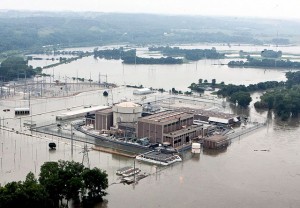![]() Tweet The flooded Fort Calhoun nuclear power plant is not exactly like the nuclear plants at Fukushima Daichi and Fukushima Diana. There are three main differences: First of all, there’s one plant, not 12. The difference of scale is tremendous. Secondly, it was offline – shut down for refueling – when flooded. Meaning, we got lucky, really lucky. Finally, it was hit by the gradually increasing pressures of rising floodwaters, not by an earthquake, a tsunami, and aftershocks. This is huge!
Tweet The flooded Fort Calhoun nuclear power plant is not exactly like the nuclear plants at Fukushima Daichi and Fukushima Diana. There are three main differences: First of all, there’s one plant, not 12. The difference of scale is tremendous. Secondly, it was offline – shut down for refueling – when flooded. Meaning, we got lucky, really lucky. Finally, it was hit by the gradually increasing pressures of rising floodwaters, not by an earthquake, a tsunami, and aftershocks. This is huge!
Steve Everly, at the Kansas City Star, reported that David Lochbaum of the Union of Concerned Scientists was “Reassured.” (here). I spoke to Mr. Lochbaum about the flooded plant on June, 29, 2011.
Most of the releases of radioactive material, generally tritium and tritiated water, occur when plants are online. Because the plant was offline, very little radioactive material has been released into the biosphere as a result of the flooding. While it is easy to filter heavy metals, it is very expensive to isolate tritiated water from water.
The damages due to the flooding are likely to be in the ballpark of $1,000,000 per day in lost revenue – $23 Million since June 6 – because the plant produces power worth about $1,000,000 per day. The buildings that have been damaged are collateral buildings, not the reactor itself. Those buildings would be less expensive to repair than the reactor.
At 35 years old, the plant is near the end of its design life. While we can engineer plants that are as safe as the NRC requires, new wind, solar, geothermal, hydro, and efficiency cost less than new nuclear or coal with carbon sequestration. Safety, security, and waste management are not the challenges with sustainable technologies that they present with nuclear and coal. Therefore, it seems logical to consider that once it is decommissioned, the plant will be replaced with wind, solar, geothermal, hydro, and efficiency.
The floods and storms we are seeing are obviously a ramification of the burning 500 billion tons of coal and oil and pumping about 1 trillion tons of carbon dioxide into the atmosphere over the last 200 years. Looking objectively at the data, including costs and risks of nuclear power, coal, carbon sequestration, wind, solar, geothermal, hydro, and efficiency, it seems a “no-brainer” that we shift to clean renewables.
Rady Ananda, at Dissident Voice, here, reported Protective Flood Berm Collapses at Ft Calhoun Nuclear Plant. The story was also repeated at Veracity Voice, here.
Overwhelmed by the rising Missouri River, a 2000-foot stretch of a protective water balloon, surrounding the Fort Calhoun nuclear power plant in Nebraska, collapsed at 1:25 AM on Sunday, June 26. Two days earlier, Kansas State University reported an emergency when radiation leaked at 149 times the Derived Air Concentration (DAC) limit for Iodine during a trial run of its reactor.
Six and a half hours after the Ft Calhoun water berm collapsed, operators reported it to the Nuclear Regulatory Commission, registering it as a “non-emergency.”
The NRC says there’s nothing to worry about. The flooding has “had no impact on the reactor shutdown cooling or the spent fuel pool cooling.”
At Popular Logistics, we know the men and women who operate nuclear power plants, and coal plants, are bright, dedicated, and hardworking people dedicated to delivering power when a switch is thrown. However, we also understand the systems dynamics of nuclear power, particularly in a de-regulated economy where costs must be contained.
—
Part of a series on the flooded Fort Calhoun and Cooper reactors on the Missouri River.
- Flooding at Nebraska Nuclear Power Plants, 6/25/11, here.
- Fort Calhoun Update, 6/29/11, here.
Fukushima coverage:
- Earthquake, Tsunami, and Energy Policy, 3/11/11, here.
- After Fukushima, Wall Street Bearish on Nuclear Power. 3/14/11, here.
- Fukushima: Worse than Chernobyl? 3/16/11, here.
- Fukushima: GE Mark 1: Unsustainable by Design, 3/17/11, here.
- Is Fukushima Dai-icha worse than Chernobyl? 3/19/11, here.
- Fukushima Warnings Ignored, 3/22/11, here.
- Why are the spent-fuel pools so hard to control? 3/23/11, here.
- Nuclear Power: What Future? 3/27/11, here.
